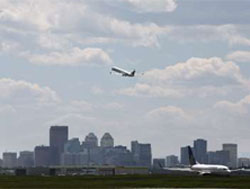Sleepy Air Canada pilot dives plane; 16 injured
AP
 Toronto, 17 Apr 2012: A sleepy Air Canada pilot who mistakenly believed his jet was about to crash into a US military plane forced a sudden dive that caused 16 injuries among passengers and crew on a transatlantic flight, a report says.
Toronto, 17 Apr 2012: A sleepy Air Canada pilot who mistakenly believed his jet was about to crash into a US military plane forced a sudden dive that caused 16 injuries among passengers and crew on a transatlantic flight, a report says.
The Transportation Safety Board report released yesterday describes the 46 seconds in which the plane dived and lurched back up during an overnight Air Canada flight from Toronto to Zurich in January 2011. Those hurt weren’t wearing seatbelts, the report said.
According to the report, the plane’s first officer was napping during a rest period aimed at combating pilot fatigue when the captain’s report on their position woke him.
At the same time, a US Air Force plane was approaching about 300 metres below. That set off cockpit alerts, which the captain mentioned to the first officer.
The "confused and disoriented" co-pilot at first mistook the planet Venus for the approaching plane, the report said. When he did spot it, he thought it was coming straight at them. He overrode the auto-pilot by forcefully pressing on the control column, pushing the jet into a dive.
Fourteen passengers and two flight attendants among the mostly 103 sleeping people aboard slammed into parts of the plane, getting cuts and bruises.
The captain regained control as the US military plane passed safely and returned the plane to its cruising altitude.
"This occurrence underscores the challenge of managing fatigue on the flight deck," Jon Lee, the investigator in charge, said in a statement.
Seven of the injured were treated in the hospital on arrival in Zurich three hours later.
The investigation found that the first officer, who had been asleep for about 75 minutes, was suffering "sleep inertia" magnified by fatigue.
The report said flight crews were not following standard procedures for "strategic napping," which is normally of 40 minutes duration. Pilots are supposed to have 15 minutes after a nap to awaken properly before taking control, according to safety protocols.
Captain Paul Strachan, president of the Air Canada Pilots Association, said the incident shows Canada needs to mandate a third pilot for eastbound transatlantic flights instead of the inflight rest periods.
"Canada’s regulations are stark in their insensitivity to the science of fatigue," Strachan said.
Air Canada spokesman Peter Fitzpatrick said the company had already taken steps to address the fatigue issues. Pilots who feel they are too tired to fly have to report it, and a non-punitive system allows them to withdraw from assignments.




 Write Comment
Write Comment E-Mail To a Friend
E-Mail To a Friend Facebook
Facebook Twitter
Twitter  Print
Print 















